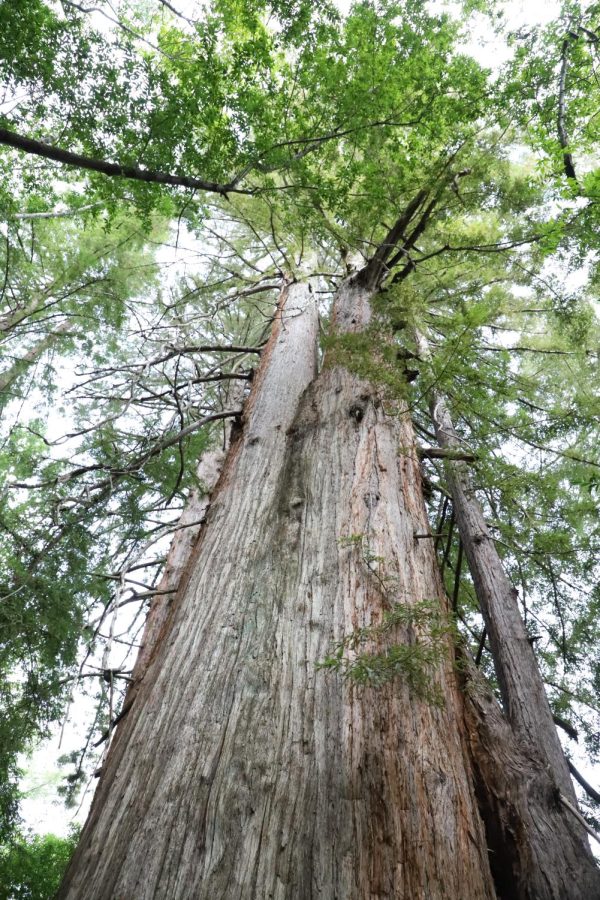Global Reset: Hero of climate change
Native California redwood trees consume carbon dioxide at unrivaled rates, suffering as environment warms
A redwood tree grows at the Bear Creek Redwoods Open Space Preserve in Los Gatos. These long-living organisms can reach heights of over 300 feet.
Leafy branches, suspended dozens of feet up in the air, cast a gentle shadow on the trodden dirt path below. Small squirrels and birds scurry around the tree, swiftly climbing from its massive, partially exposed roots to its thousands of green needles. This redwood tree, standing at about 300 feet tall, is a hero: not only do its rich nutrients provide ample food for surrounding amphibians and insects, but it also preserves other life on earth by combating climate change.
The impressive redwood tree is native to Northern California and flourishes in the cool, damp climate of the Pacific coast. Although the tree has humble beginnings as a small seed, don’t be fooled: redwoods can reach a height of around 367 feet and grow a base width of 22 feet. Their 600-year life expectancy and fire-resistant, thick bark serve as a stabilizing force in their natural environments, providing long-lasting resources for surrounding organisms. For example, redwood forests are often populated with various other species of trees, such as Douglas-firs and tanoaks, that benefit from the nutrients supplied by the redwoods’ complex root system.
Not only do redwood trees support other organisms in their local ecosystems, but they also play an important role in mitigating the effects of climate change. Their incredible size means that redwoods consume large volumes of carbon dioxide simply by living. In fact, just one acre of these trees stores about 1,000 metric tons of carbon, more than double of an average conifer tree, according to a 2016 study published in the Forest Ecology and Management journal.
“Since redwood trees capture a lot of carbon dioxide, it’s really important to make sure that they are continuing to grow,” Green Team treasurer Thresia Vazhaeparambil (12) said. “Without that, there is going to be a very severe impact on the biodiversity around them and the ecosystem as a whole.”
Redwood trees are commonly praised for significantly reducing carbon dioxide emissions in the atmosphere. Unfortunately, climate change has detrimentally affected the species, according to redwood conservationist non-profit organization Save the Redwoods League. Upper school biology and environmental science teacher Jeff Sutton notes how increasing temperatures could potentially stunt the growth of redwood forests as well as their biotic communities.
“Ultimately, those trees are considered to be like the climax organism of that ecosystem: they’re the ones that perpetuate the ecosystem,” Sutton said. “If the climate gets too warm or there’s not enough rainfall, which is what we’re experiencing, then fires are more likely, [and] the trees have a more difficult time living.”
Wildfires in northern California over the past few years have decimated healthy forests. In 2021 alone, 2.6 million acres of land, including forests, and thousands of structures were burned by the fires.
The Big Basin Redwoods State Park, located nearby in Santa Cruz, was forced to close down in August 2020 because of severe wildfire damage from the CZU Lightning Complex fire. Wildfires swept through 97% of the forest.
For the past one and a half years, the park has been rebuilding and caring for the damaged land, with staff and volunteers working to clear debris. Additionally, after the wildfire event, California State Parks began collecting data for a forest management strategy focused on the stewardship of California trees, including redwoods. Together communities can change their everyday actions to limit their contributions to climate change.
“There are really basic things that everybody can do in their lives,” Green Team secretary Siddhi Jain (10). “For example, we have signs out there that say ‘don’t idle when you’re waiting in your car’ because that’s contributing to greenhouse gases, which are warming the climate. Just take action to reduce your carbon footprint.”
According to Sutton, being educated and recognizing human contributions to climate change are only the first steps in mitigating its negative effects. Changing individual lifestyles in small steps actively helps the environment.
“We have to continue being involved, not being disconnected from ecosystems in nature,” Sutton said. “We have to be connected to it and realize that our activities can have good and bad consequences for nature. Once you’re educated, you can’t despair: you have to find things that you can do to make a difference.”If you would like to visit some of these natural giants yourselves, some local parks are the Bear Creek Redwoods Open Space Preserve in Los Gatos, the Big Basin Redwoods State Park in Santa Cruz, and the Redwood National Park in Orick, near the Oregon border.

Sabrina Zhu (12) is the co-editor-in-chief of the Winged Post, and this is her fourth year on staff. Sabrina hopes to capture more campus life through...

Lavanya Subramanian (12) is the co-editor-in-chief of the TALON yearbook, and this is her fourth year on staff. This year, she looks forward to working...


















![“[Building nerf blasters] became this outlet of creativity for me that hasn't been matched by anything else. The process [of] making a build complete to your desire is such a painstakingly difficult process, but I've had to learn from [the skills needed from] soldering to proper painting. There's so many different options for everything, if you think about it, it exists. The best part is [that] if it doesn't exist, you can build it yourself," Ishaan Parate said.](https://harkeraquila.com/wp-content/uploads/2022/08/DSC_8149-900x604.jpg)




![“When I came into high school, I was ready to be a follower. But DECA was a game changer for me. It helped me overcome my fear of public speaking, and it's played such a major role in who I've become today. To be able to successfully lead a chapter of 150 students, an officer team and be one of the upperclassmen I once really admired is something I'm [really] proud of,” Anvitha Tummala ('21) said.](https://harkeraquila.com/wp-content/uploads/2021/07/Screen-Shot-2021-07-25-at-9.50.05-AM-900x594.png)







![“I think getting up in the morning and having a sense of purpose [is exciting]. I think without a certain amount of drive, life is kind of obsolete and mundane, and I think having that every single day is what makes each day unique and kind of makes life exciting,” Neymika Jain (12) said.](https://harkeraquila.com/wp-content/uploads/2017/06/Screen-Shot-2017-06-03-at-4.54.16-PM.png)








![“My slogan is ‘slow feet, don’t eat, and I’m hungry.’ You need to run fast to get where you are–you aren't going to get those championships if you aren't fast,” Angel Cervantes (12) said. “I want to do well in school on my tests and in track and win championships for my team. I live by that, [and] I can do that anywhere: in the classroom or on the field.”](https://harkeraquila.com/wp-content/uploads/2018/06/DSC5146-900x601.jpg)
![“[Volleyball has] taught me how to fall correctly, and another thing it taught is that you don’t have to be the best at something to be good at it. If you just hit the ball in a smart way, then it still scores points and you’re good at it. You could be a background player and still make a much bigger impact on the team than you would think,” Anya Gert (’20) said.](https://harkeraquila.com/wp-content/uploads/2020/06/AnnaGert_JinTuan_HoHPhotoEdited-600x900.jpeg)

![“I'm not nearly there yet, but [my confidence has] definitely been getting better since I was pretty shy and timid coming into Harker my freshman year. I know that there's a lot of people that are really confident in what they do, and I really admire them. Everyone's so driven and that has really pushed me to kind of try to find my own place in high school and be more confident,” Alyssa Huang (’20) said.](https://harkeraquila.com/wp-content/uploads/2020/06/AlyssaHuang_EmilyChen_HoHPhoto-900x749.jpeg)





